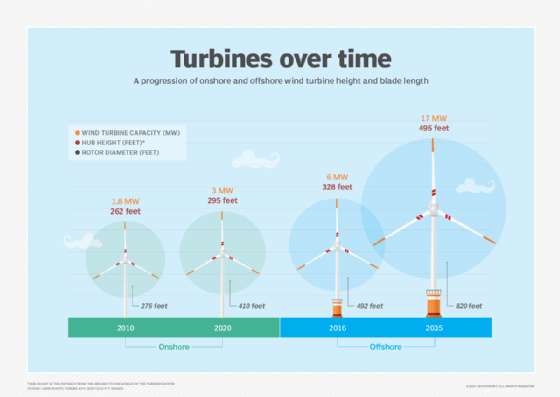
How to use data center wind turbines for sustainable energy
Wind power is a promising way for data centers to cut carbon footprints. Despite challenges, evolving technology offers efficient turbines for substantial electricity generation.
The increasing energy consumption of data centers is prompting administrators to explore and adopt sustainable energy solutions within their infrastructure. Wind turbines, which harness wind power, are becoming a promising source of renewable energy for data centers.
Wind turbines are increasing in size to generate more power, but this increases the amount of space they occupy. This article explores wind turbines' energy generation and efficiency, ideal locations, challenges in implementation and which companies use wind to power their data centers.
Wind turbine energy generation and efficiency
The electricity a wind turbine generates mainly depends on the wind speed and the specific type of turbine in use -- vertical or horizontal. The technology has rapidly evolved over the last decade. Modern onshore turbines have a capacity of 3 megawatts to 4 MW, and offshore turbines have a capacity of 8 MW to 12 MW, according to the International Renewable Energy Agency.
Modern wind turbines are taller, with longer blades and larger rotor diameters. This design enables them to sweep a greater area, effectively capture more wind -- even in areas with less wind -- and generate more electricity.
With higher altitudes, wind flows more freely, and speeds typically increase. High altitudes and water locations have less friction from objects on the Earth's surface, such as trees, mountains and buildings. This is why offshore turbines generate more electricity, even at shorter heights.
Ideal locations for wind turbines
For onshore wind turbines, areas with higher-than-average wind shear -- the change in wind speed with altitude -- are ideal for wind farms. According to Berkeley Lab's "Land-Based Wind Market Report: 2024 Edition," most wind turbine towers taller than 110 meters are concentrated in the Midwest and Northeast U.S. because they have higher wind shear.
Direct land use and total wind farm area
Wind turbines do not have a large footprint on the ground, but they take up significant airspace. According to the University of Michigan's Center for Sustainable Systems wind energy factsheet, the direct land use of a wind turbine in the U.S. is 85 acres (0.13 square miles) per MW of installed capacity, with the tower pad and access roads occupying 1% of the area. This means a 2-3 MW wind turbine occupies 170 to 255 acres (0.27 to 0.40 square miles) of land.
A larger challenge is installing multiple turbines. A wind farm needs considerable space between the turbines to minimize turbulence, follow natural land contours and avoid other obstacles. A single turbine should be spaced approximately seven rotor diameters away from another wind turbine. This spacing protects the turbine and nearby structures from turbulence, and it enables the turbine to work optimally.
According to the U.S. Department of Energy, the average rotor diameter of a modern wind turbine is 133.8 meters (438.98 feet). That means the amount of airspace between turbines should be 936.6 meters (3,072.83 feet), or 0.58 miles. Much of the indirect land under the turbines can be used for other purposes, like agricultural farms and ranching. Many existing wind farms are in agricultural areas in the Midwest U.S.

Challenges of wind power for data centers
Using wind power for data centers presents several challenges, including space, generational limits and government regulations.
Space
The main challenge is space -- not just for installation, but for transporting material. Large rotor blades are difficult to transport because they cannot be folded or bent once constructed. This limits transportation routes and turn radii. Taller turbines have large tower diameters, making them difficult to fit under bridges or highway overpasses.
Since most data centers are in areas with travel limitations, it is challenging for facility owners to install their own high-capacity wind farms. Vertical turbines can be installed closer together than horizontal ones. However, vertical wind turbines produce less energy than horizontal ones.
Generational limits
By 2023, U.S. data centers, which power AI workloads, servers and containers, required a minimum of 176 terawatt-hours, far exceeding the combined output of horizontal turbines. Wind energy can help with sustainable goals, but without a large amount of land use, it is not feasible for only wind power to generate enough energy to run a large data center.
Government regulations
Wind zoning regulations in the U.S. are primarily driven by local municipal areas, making it challenging for data center owners to navigate requirements. Many areas lack comprehensive regulations for wind power beyond transportation and logistics guidelines. This leads to arbitrary rules, such as turbine setback requirements, which vary widely between jurisdictions.
Companies using wind power
Tech giants, like AWS, Google, Meta and Microsoft, partner with wind farm owners and renewable energy companies to use wind power as part of their renewable energy programs.
According to AWS, the company invests in wind and solar energy to advance its green energy goals. AWS will soon have three wind farms in Greece that will lessen stress on the electric grid and support the country's renewable energy goal. AWS partners with other sustainable energy companies focusing on wind power in states such as Oregon and Texas.
Google has said that the company has power purchase agreements with the Netherlands to enable offshore wind turbines to power Dutch data centers. The company also has an agreement with Italy to have an onshore wind turbine project that could generate 47 MW of clean energy through ERG, a renewable energy company.
Microsoft has said the company has a power purchase agreement with Vattenfall, an electricity provider in the Netherlands, to purchase 100% wind energy to power its local data centers. Microsoft also has wind power agreements in Ireland and Wyoming.
Other data center facilities utilizing wind power include the following:
- EcoDataCenter (Sweden). Powered 100% by renewable methods, including 25% wind.
- Kao Data (U.K). Powered 100% by renewable resources, wind power being one of them.
- Virtus Data Centres (U.K.), Switch (U.S.) and Scala Data Centers (Brazil). All powered by a combination of wind, solar and hydroelectric power.
While wind power alone may not be sufficient to meet the large energy demands of modern data centers, especially those powering AI workloads, it remains a valuable component of a diversified renewable energy strategy. As the industry continues to innovate and adapt, wind-powered data centers will likely play an increasingly important role in the quest for sustainable energy.
Julia Borgini is a freelance technical copywriter, content marketer, content strategist and geek. She writes about B2B tech, SaaS, DevOps, the cloud and other tech topics.








